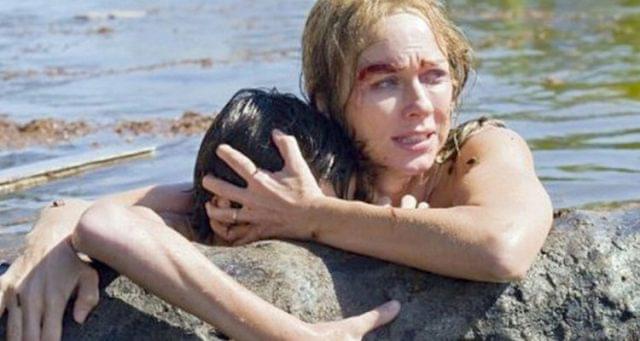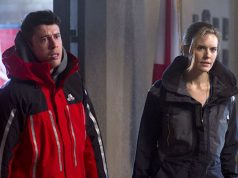
Some 250,000 people died in the tsunami that hit Southeast Asia the day after Christmas in 2004, the fourth-highest toll of any natural disaster of the previous hundred years. That’s a quarter-million stories that ended unhappily, not to mention the countless others that ended with their protagonists alive but injured, impoverished, or heartbroken. The task of making a movie about the tsunami that is not in poor taste seems almost unfeasible. You have to honor the victims and avoid exploiting their tragedy, which means the story you tell probably needs to be a true one. But at the same time, audiences want a triumphant film, one where at least some of the main characters survive. True stories like that, unfortunately, are in short supply.
In other words, “The Impossible” is an excellent title for this harrowing film. Directed with aching sensitivity by Juan Antonio Bayona (“The Orphanage”), it tells a fact-based story about people who achieved something that sounds impossible, and does so in a way that doesn’t diminish the tragedy of those who weren’t as fortunate. Even though some of the characters we follow are extraordinarily blessed, they’re always aware of how lucky they are — and thus, so are we. We can rejoice in their victories while still mourning those who were lost.
The real people who had this experience were tourists from Spain, a fact that gives some viewers pause right off the bat. Why not tell an inspiring story about some of the local people — you know, the ones who lost their homes and communities, not their hotels and expense accounts? I don’t have an answer for that. For the film, the family has been caucasianed up and made British, with Naomi Watts and Ewan McGregor as the parents, probably for no more sinister reason than the unfortunate reality of the movie business, which is that movies with white stars generally do better than movies with Spanish stars (let alone Asian ones). I don’t have an answer for that either. My point is that if you’re hung up on the casting, watching the film probably won’t help.
Watts and McGregor’s characters, Maria and Henry, are at an upscale new Thai resort for the holidays with their sons, Lucas (Tom Holland), Thomas (Samuel Joslin), and Simon (Oaklee Pendergast), of whom the oldest, Lucas, is only about 13. The tsunami hits them without warning, though the same can’t be said for us: we’re dreading it from the first minute, watching as this oblivious family and their fellow tourists go about the mundane details of their vacations. When the disaster arrives, it does so quickly, and Bayona doesn’t glamorize it or turn it into an adventure. Using miniatures, models, and water tanks as much as possible and CGI as little as possible, he delivers a tsunami that is spine-tinglingly realistic, made more dramatic by having someone specific to follow — Maria, whose point of view we hold as she’s tossed around underwater, thrown against rocks and debris, desperately fighting for breath while struggling to keep tabs on her family.
We stick with Maria and Lucas for a while, knowing no more about the status of Henry and the two younger boys than they do. (Maria and Lucas assume they’re dead; we, knowing that you don’t put Ewan McGregor in a film only to drown him in the first 20 minutes and never show him again, suspect that at least Henry has survived.) With Maria badly hurt, the mother-and-son dynamic shifts, and Lucas has to take charge as they await rescue. (Fifteen-year-old Tom Holland’s performance is remarkably authentic and mature.) Yet he remains a scared young boy, one who needs to be taught by his mom to look out not just for himself and his family but for those around him. Later, at a local hospital completely overwhelmed by the disaster, Maria urges Lucas to leave her bedside and go see what help he can provide others. His heart is warmed to see parents and children reunited, even as he continues to doubt his father and brothers will be as lucky.
That theme reverberates throughout the film. The ennobling “we’re all in this together” mentality that tends to emerge during a large-scale crisis is seen frequently here, both among the tourists and the locals. Strangers are willing to help one another, cooperating more selflessly than they do in normal life. Through Lucas’ eyes, we see the beauty of these seemingly small acts of kindness. The casualties are almost incomprehensibly numerous, the disaster so huge that it seems almost pointless to try to help one person. But if you’re that one person…
The movie’s a tear-jerker, obviously. I can’t imagine that anyone who has children can watch a movie like this without feeling some of the panic and desperation that Maria and Henry feel, not to mention the other emotions (at both ends of the spectrum) that arise. Cathartic relief comes eventually, though perhaps not in the manner or at the point in the story you would expect. Without falsely manipulating us, Bayona and screenwriter Sergio G. Sanchez (who also wrote “The Orphanage”) take us through every aspect of the family’s experience — a rewarding process, both dramatically and emotionally. Their story may not be typical, but the family represents the resilience, compassion, and optimism of the whole human race.
B+ (1 hr., 54 min.; )





